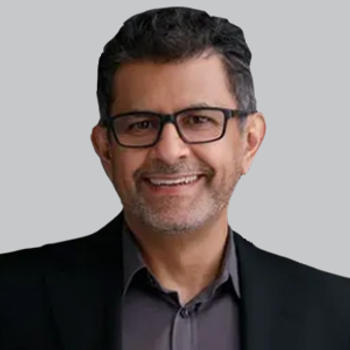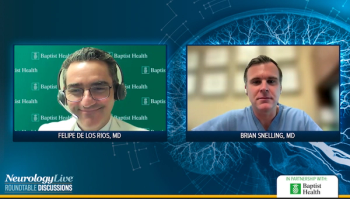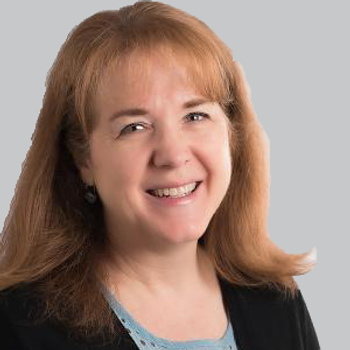
Sleep Efficiency Moderates Language Therapy Effects in Primary Progressive Aphasia
Among participants with high sleep efficiency, those who received transcranial direct current stimulation benefitted more from language therapy than those who received sham, whereas those with low sleep efficiency demonstrated no additional benefit.
Baseline sleep efficiency was shown to have an impact on the effect of either language therapy alone or when coupled with transcranial direct current stimulation (tDCS) in patients with primary progressive aphasia (PPA). These findings suggest that sleep may be a determinant of neuromodulation effects, and that individuals who have higher sleep efficiency benefit the most.
Effect size, or raw difference, of sleep efficiency predicting therapy outcomes for trained words were calculated as a percentage of standard deviation. Immediately after therapy, the effect size was 82% between the high- and low-sleep efficiency groups. At 2-weeks and 2-months post-therapy, the effect sizes were 62% and 76%, respectively, with no effect of sleep efficiency in generalization of therapy materials.
Among individuals with neurodegenerative disease, it has been documented that underlying pathology and atrophy in sleep-related regions of the brain lead to poor sleep quality. PPA, a subtype of frontotemporal lobar degeneration, principally affects sleep and language. In this crossover, sham-controlled, double-blind trial (NCT02606422), investigators aimed to determine whether sleep efficiency prior to receiving therapy predicted outcomes of tDCS and language therapy.
To do so, senior author Kyrana Tsapkini, PhD, associate professor of neurology, Johns Hopkins Medicine, and colleagues assessed 23 participants with PPA who received anodal tDCS over the left inferior frontal gyrus coupled with written naming/spelling therapy. Sleep quality was self-reported through a packet of questionnaires at baseline, including the Pittsburgh Sleep Quality Index (PSQI). All participants underwent 2 periods of therapy, separated by 2 months, that compared anodal tDCS and language therapy versus sham tDCS and language therapy.
The main outcome of the study was percent of letters spelled correctly for trained and untrained words retrieved in a spelling task called Copy and Recall Training (CART). Each participant was presented a picture on the computer and asked to produce the target word verbally and then in written form. If they had difficulty, semantic knowledge was evaluated using the principles of Semantic Feature Analysis. If semantic knowledge did not cue the target word, the participant was verbally presented the word and asked to repeat it 3 times.
At baseline, there were no statistically significant demographic differences between groups based on treatment order (tDCS vs sham) or sleep efficiency (high vs low). At any time, which included immediately after, 2-weeks post, and 2-months post treatment, those with high sleep efficiency benefitted more from therapy, irrespective oftreatment (tDCS or sham), than those with low-sleep efficiency in learning therapy materials.
"Advocating for the role of sleep as a modifier of language therapy outcomes may prompt referrals to sleep specialists and discussions of pharmacologic options for individuals prior to beginning language therapy both in poststroke aphasia and in neurodegenerative conditions with language deficits,” the investigators wrote. "Addressing disrupted sleep may also lead to improved language performance and overall quality of life, which emphasizes further investigation of sleep in relation to behavioral, pharmacological, and neuromodulatory treatments in aphasia."
Tsapkini et al also observed greater benefit from tDCS compared to sham in the high-sleep efficiency group. At 2-months post-therapy, the effect size, calculated as a percentage of standard deviation of sleep efficiency predicting therapy outcomes, was 352%. In comparison, those with low sleep efficiency did not demonstrate additional benefits from tDCS.
There are limitations to the study, including the fact that all sleep measures were self-reported and approximately half of the sample reported sleep efficiency to be 100%. They noted that this is unlikely because older adults typically have a sleep efficiency below 80%; however, they noted that the unusually high mean of sleep may suggest that even small disturbances at sleep are a particularly sensitive predictor of therapy outcomes.
"Our study showed that those individuals with high sleep efficiency benefit more from tDCS," Tsapkini et al wrote. "But, could tDCS be applied to enhance sleep which could then improve therapy outcomes? While the present results do not address this hypothesis, tDCS application during both wakefulness and sleep should be studied as adjunct options to language recovery in neurodegenerative diseases."
REFERENCES
1. Herrmann O, Ficek B, Webster KT, Frangakis C, Spira AP, Tsapkini K. Sleep as a predictor of tDCS and language therapy outcomes. Sleep. 2021; zsab275. doi:10.1093/sleep/zsab275
Newsletter
Keep your finger on the pulse of neurology—subscribe to NeurologyLive for expert interviews, new data, and breakthrough treatment updates.









































